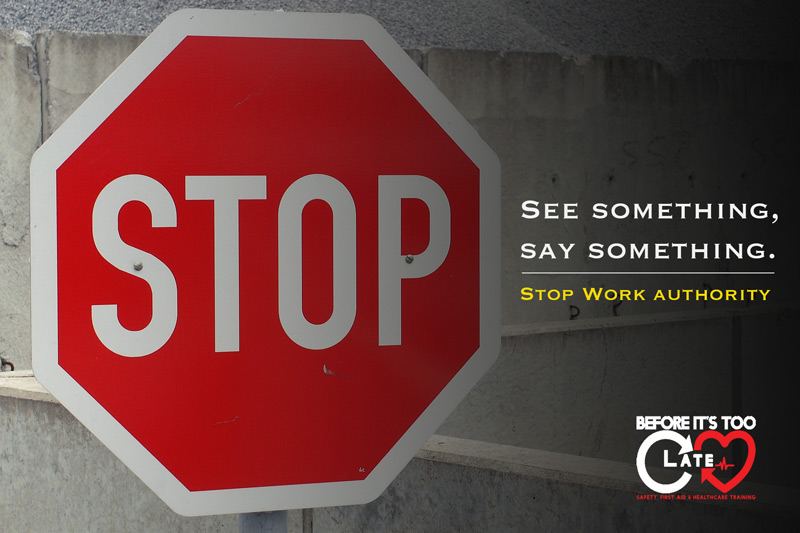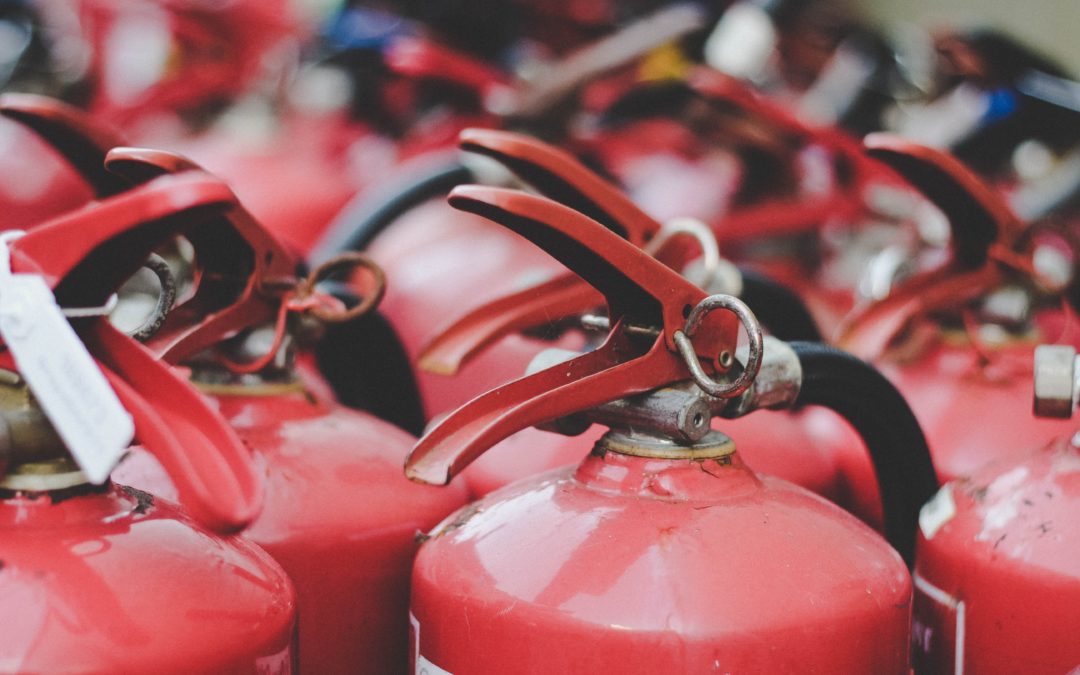
Aug 24, 2021 | Professional, Safety
Stop Work Authority
When performing work, it is important that an employee feels empowered and is knowledgeable that he/she has the authority to stop work if an unsafe hazard is evident that prohibits the employee from conducting a task. Stopping work is, at times, a sensitive power depending on the industry. There are employees that are fearful to use this power. The lack of confidence that employees have to exercise this right can escalate a situation and make a situation worse than it needs to be.
Reasons Why Employees Hesitate to Use Stop Work Authority:
- Fear of punishment from supervisor
- Fear of conflict with other employees
- Does not want to be labeled as a “snitch” or “soft worker”
- Fear of losing job
- Does not want to slow project or work down
Clearly, many of the reasons why employees hesitate to exercise stop work authority revolve around fear of losing something. One recommendation to feel more confident about using stop work authority is to review all hazards associated with your job and position with your Human Resources manager and explain any grey areas that might exist.
Despite what many employers and groups express or claim, stop work authority is not just a privilege, it is a responsibility. Your job as a safe employee is to be the first set of eyes and voice while on the clock. At the end of the day, stopping work can keep you, your coworkers, and your company safe.
“But Sam, it’s not that simple. I tried stopping work and my boss yelled at me and threatened to fire me.”
Unfortunately, some managers care more about how quickly a job gets completed than the safety of their workers. Many of these managers feel threatened or fearful that if one of their employees stops work, the higher ups in that company may think the manager does not have control over their group. This is not the case though! Your choice and ability to identify a risk or potential hazard can save a lot of harm, if conducted correctly.
Stop Work Abuse
As mentioned earlier, stop work authority is a power that comes with great responsibility. Many employers and managers have fears that employees may tend to abuse this power to get out of work. Because of this, it is important that safety talks be conducted prior to beginning a job or task to make sure all parties are aware of the potential hazards. Abuse of stop work authority can lead to reprehension and loss of job security. Be honest, be safe, and if you see something, say it.
How to Stop Work
If you see a potential hazard, risk or unsafe action, your job is to contact your direct supervisor or safety representative immediately. Also, alert any co-workers or employees that are assigned to the specific task as well. At that point, the manager or safety representative will analyze the issue and take corrective actions in order to resolve the issue.
Final Thoughts
All things considered, stop work is a crucial responsibility that employees should feel comfortable exercising. If there is a potential safety hazard that could cause an accident, the issue should be made known. Knowing the steps for how to stop work and who to approach is the first step of using this responsibility to create a safer work environment. If you have issues or fear of using such authority, contact your supervisor directly and your Human Resources team to make you feel comfortable in the workplace.
Did this article help? We hope this toolbox talk was informative, helpful and easy to relate to. Please visit safetytalkideas.com and B42L.com to learn more about safety talks and topics.

Feb 17, 2019 | Professional, Safety
Does
anyone else remember being in grade school and out of nowhere, the entire
building’s alarm system was activated? “Here we go again.” I would say. Yes, I
am talking about our monthly fire drills at school. No matter the weather, time
of the day, or special events going on, those pesky teachers always found a way
to make us stop what we were doing for a routine fire drill. Although these
very redundant and at times what felt pointless exercises were taught, I didn’t
realize how important fire safety was. It also didn’t help that my main source
of fire safety awareness came from Dwight Schrute while watching The Office. Come
on though, rookie mistake on Ryan’s part leaving his bread in the toaster for
that long.
Fast
forward about 10 years, I was working as a hand in the oil and gas fields and
was taking safety training when the topic of fires and emergency action plans
was brought up. After learning about the different fires that took place and
different ways to fight a fire, I was shocked of the different types of fires
that could be created and the different ways you should fight each fire. This is
useful information that should be taught at an earlier age in my opinion, its
never too early to start thinking smart and safe!
Below, we
will be discussing the 3 most popular fire extinguisher types on the market and
when to use each of them if a fire starts. Feel free to use this short post as
a crash course into the fire-fighting sector, but always feel confident to call
your local emergency fire response team if a fire starts.
The most common types of fire
extinguishers used on different types of fire fuels are:
- Water fire extinguisher
Water fire extinguishers douse fires by taking away the heat element of the
fire triangle. They’re used for Class A fires only. - Dry chemical fire extinguisher
Dry chemical extinguishers extinguish the fire by interrupting the chemical
reaction of the fire triangle. They’re most effective on Class A, B and C
fires. - CO2 fire extinguisher
Carbon dioxide extinguishers take away the oxygen element of the fire triangle.
They also remove the heat with a cold discharge. They can be used on Class B
and C fires.
With this in mind, fire extinguishers have been developed and classified in order to combat such fires. Below is a chart of the 3 most popular fire extinguishers to deal with fires:
Type of
Extinguisher |
What the fire extinguishers are used for:
|
| Class A fire extinguisher | These extinguishers are used for fires involving ordinary combustibles, such as wood, paper, cloth, trash and plastics. |
|
Class B fire extinguisher
| These extinguishers are used for fires involving flammable liquids, such as grease, gasoline and oil. |
|
Class C fire extinguisher
|
These extinguishers are used for fires involving electrical
equipment, such as motors, transformers and appliances.
|
|
We now
have a basic understanding of what extinguishers fight what fires. But what
about when you are face to face with the fire? That is the very scary and at
times overwhelming point where your knowledge and skills will be put to the test.
This post also stresses that fire extinguishers should not be used to fight
larger fires, please leave that to the professionals. These tools can be used
for fires that have just started and are containable.
The acronym
PASS is an easy way to remember how
to use a fire extinguisher:
P- Pull
the pin
A- Aim at
the base of the fire
S- Squeeze
the lever steadily and evenly. Squeezing too hard can waste the fire-fighting
agent
S- Sweep the
nozzle side to side, continuing to aim at the base of the fire
What do we do from here?
Well, now
that we have a basic understanding on how fires are started, the types of fires
that take place and which fire extinguishers should be used, I recommend seeking
further education and going through a fire safety course from a trained
professional or your local fire-fighting department. At the very least, take a
look at the extinguisher you have in your homes, work place, or local community
centers. Are these the right extinguishers for a fire that might occur? Please
make sure you if a fire breaks loose, calling professionally trained first
responders is always the preferred route.
Was this helpful?
If you found this article interesting, exciting or useful, please check out more safety related articles at https://b42l.com






